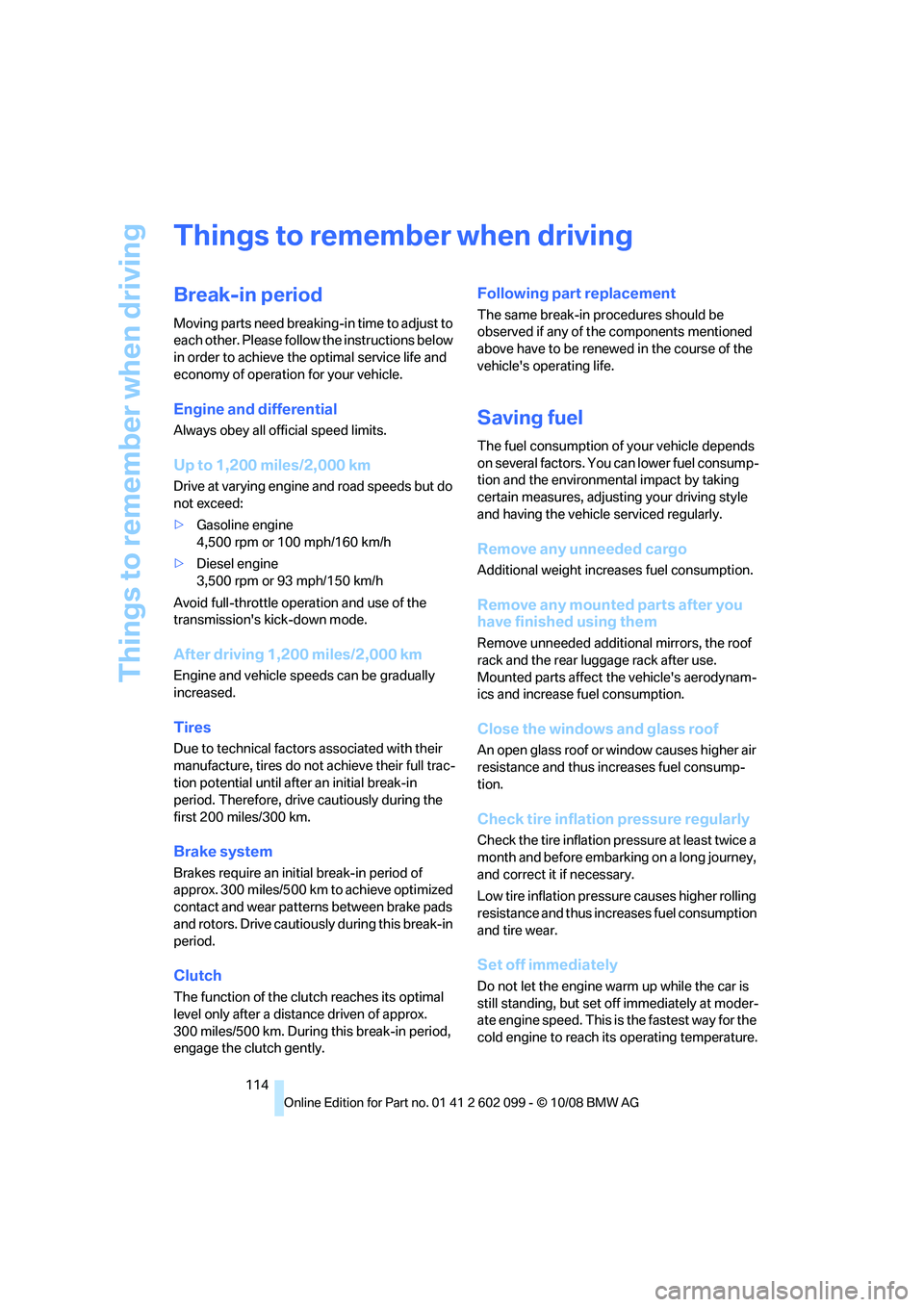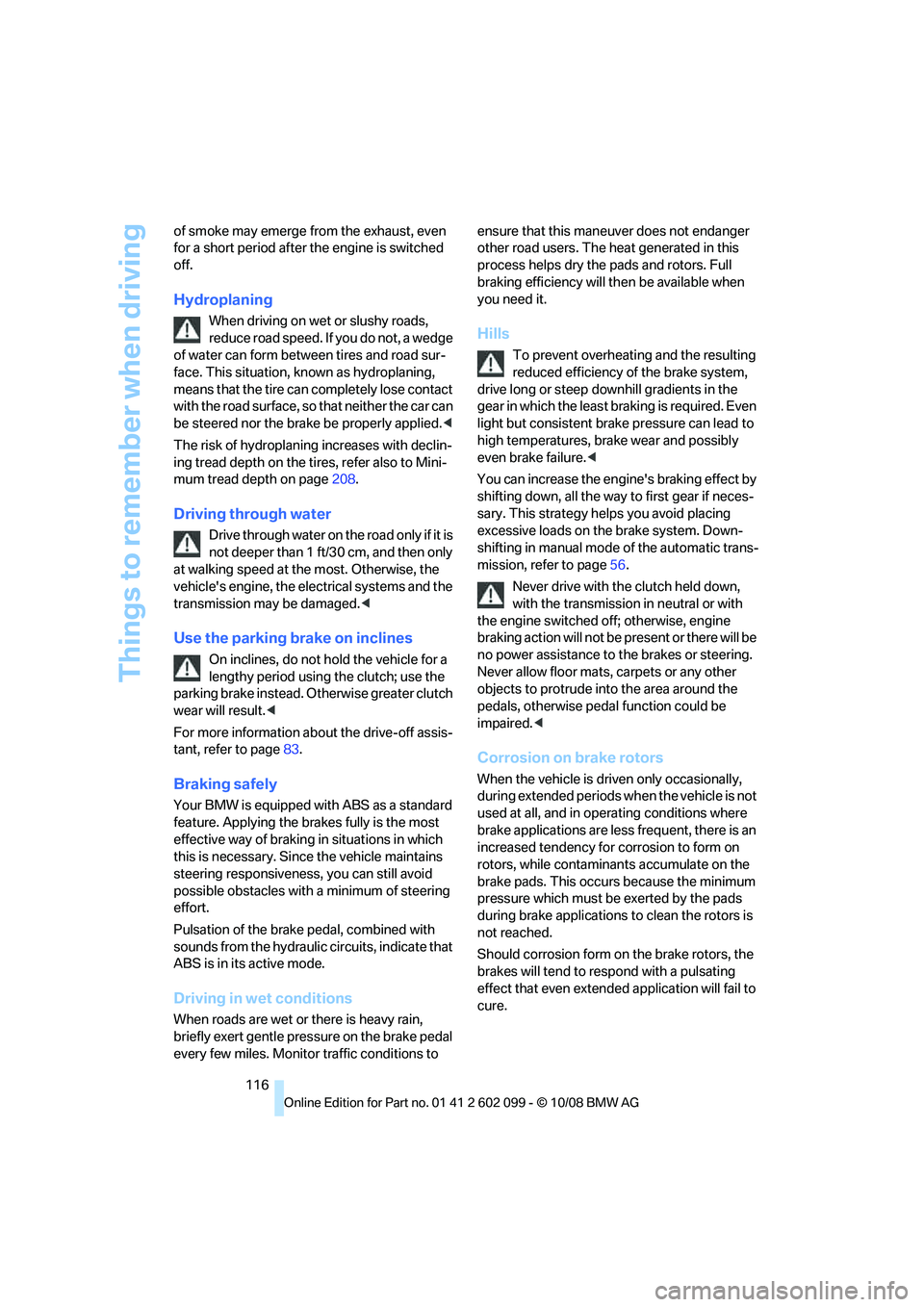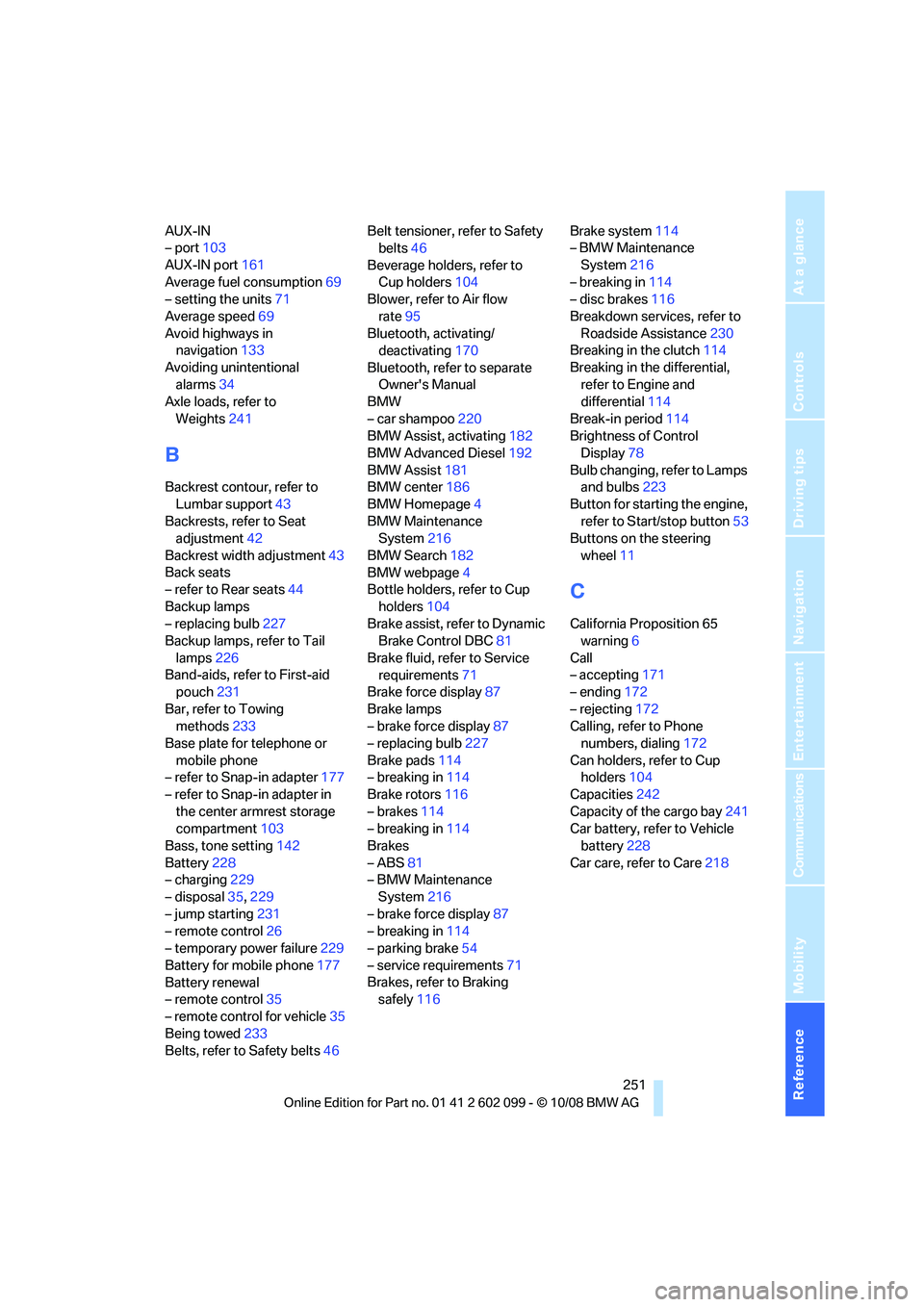2009 BMW 335I XDRIVE brake rotor
[x] Cancel search: brake rotorPage 116 of 268

Things to remember when driving
114
Things to remember when driving
Break-in period
Moving parts need breaking-in time to adjust to
each other. Please follow the instructions below
in order to achieve the optimal service life and
economy of operation for your vehicle.
Engine and differential
Always obey all official speed limits.
Up to 1,200 miles/2,000 km
Drive at varying engine and road speeds but do
not exceed:
> Gasoline engine
4,500 rpm or 100 mph/160 km/h
> Diesel engine
3,500 rpm or 93 mph/150 km/h
Avoid full-throttle operation and use of the
transmission's kick-down mode.
After driving 1,200 miles/2,000 km
Engine and vehicle speeds can be gradually
increased.
Tires
Due to technical factors associated with their
manufacture, tires do no t achieve their full trac-
tion potential until afte r an initial break-in
period. Therefore, drive cautiously during the
first 200 miles/300 km.
Brake system
Brakes require an initial break-in period of
approx. 300 miles/500 km to achieve optimized
contact and wear patterns between brake pads
and rotors. Drive cautiously during this break-in
period.
Clutch
The function of the clut ch reaches its optimal
level only after a distan ce driven of approx.
300 miles/500 km. During this break-in period,
engage the clutch gently.
Following part replacement
The same break-in procedures should be
observed if any of the components mentioned
above have to be renewe d in the course of the
vehicle's operating life.
Saving fuel
The fuel consumption of your vehicle depends
on several factors. You can lower fuel consump-
tion and the environmental impact by taking
certain measures, adjusting your driving style
and having the vehicle serviced regularly.
Remove any unneeded cargo
Additional weight incr eases fuel consumption.
Remove any mounted parts after you
have finished using them
Remove unneeded additional mirrors, the roof
rack and the rear luggage rack after use.
Mounted parts affect th e vehicle's aerodynam-
ics and increase fuel consumption.
Close the windows and glass roof
An open glass roof or window causes higher air
resistance and thus increases fuel consump-
tion.
Check tire inflation pressure regularly
Check the tire inflation pr essure at least twice a
month and before embarking on a long journey,
and correct it if necessary.
Low tire inflation pressure causes higher rolling
resistance and thus increases fuel consumption
and tire wear.
Set off immediately
Do not let the engine wa rm up while the car is
still standing, but set off immediately at moder-
ate engine speed. This is the fastest way for the
cold engine to reach its operating temperature.
ba8_E9091_cic.book Seite 114 Mittwoch, 29. Oktober 2008 2:59 14
Page 118 of 268

Things to remember when driving
116
of smoke may emerge from the exhaust, even
for a short period after
the engine is switched
off.
Hydroplaning
When driving on wet or slushy roads,
reduce road speed. If you do not, a wedge
of water can form between tires and road sur-
face. This situation, known as hydroplaning,
means that the tire can completely lose contact
with the road surface, so that neither the car can
be steered nor the brak e be properly applied.<
The risk of hydroplaning increases with declin-
ing tread depth on the tire s, refer also to Mini-
mum tread depth on page 208.
Driving through water
Drive through water on the road only if it is
not deeper than 1 ft/30 cm, and then only
at walking speed at the most. Otherwise, the
vehicle's engine, the electrical systems and the
transmission may be damaged. <
Use the parking brake on inclines
On inclines, do not hold the vehicle for a
lengthy period using the clutch; use the
parking brake instead. Ot herwise greater clutch
wear will result. <
For more information about the drive-off assis-
tant, refer to page 83.
Braking safely
Your BMW is equipped with ABS as a standard
feature. Applying the brakes fully is the most
effective way of braking in situations in which
this is necessary. Since the vehicle maintains
steering responsiveness, you can still avoid
possible obstacles with a minimum of steering
effort.
Pulsation of the brake pedal, combined with
sounds from the hydraulic circuits, indicate that
ABS is in its active mode.
Driving in wet conditions
When roads are wet or there is heavy rain,
briefly exert gentle pre ssure on the brake pedal
every few miles. Monitor traffic conditions to ensure that this maneuver does not endanger
other road users. The heat generated in this
process helps dry the pads and rotors. Full
braking efficiency will th
en be available when
you need it.
Hills
To prevent overheating and the resulting
reduced efficiency of the brake system,
drive long or steep downhill gradients in the
gear in which the least br aking is required. Even
light but consistent brak e pressure can lead to
high temperatures, brake wear and possibly
even brake failure. <
You can increase the engine's braking effect by
shifting down, all the way to first gear if neces-
sary. This strategy helps you avoid placing
excessive loads on the brake system. Down-
shifting in manual mode of the automatic trans-
mission, refer to page 56.
Never drive with the clutch held down,
with the transmission in neutral or with
the engine switched off; otherwise, engine
braking action will not be present or there will be
no power assistance to the brakes or steering.
Never allow floor mats, carpets or any other
objects to protrude into the area around the
pedals, otherwise peda l function could be
impaired. <
Corrosion on brake rotors
When the vehicle is driv en only occasionally,
during extended periods when the vehicle is not
used at all, and in op erating conditions where
brake applications are less frequent, there is an
increased tendency for corrosion to form on
rotors, while contaminan ts accumulate on the
brake pads. This occurs because the minimum
pressure which must be exerted by the pads
during brake applications to clean the rotors is
not reached.
Should corrosion form on the brake rotors, the
brakes will tend to re spond with a pulsating
effect that even extended application will fail to
cure.
ba8_E9091_cic.book Seite 116 Mittwoch, 29. Oktober 2008 2:59 14
Page 253 of 268

Reference 251
At a glance
Controls
Driving tips
Communications
Navigation
Entertainment
Mobility
AUX-IN
– port103
AUX-IN port 161
Average fuel consumption 69
– setting the units 71
Average speed 69
Avoid highways in navigation 133
Avoiding unintentional alarms 34
Axle loads, refer to
Weights 241
B
Backrest contour, refer to
Lumbar support 43
Backrests, refer to Seat adjustment 42
Backrest width adjustment 43
Back seats
– refer to Rear seats 44
Backup lamps
– replacing bulb 227
Backup lamps, refer to Tail
lamps 226
Band-aids, refer to First-aid pouch 231
Bar, refer to Towing methods 233
Base plate for telephone or
mobile phone
– refer to Snap-in adapter 177
– refer to Snap-in adapter in
the center armrest storage
compartment 103
Bass, tone setting 142
Battery 228
– charging 229
– disposal 35,229
– jump starting 231
– remote control 26
– temporary power failure 229
Battery for mobile phone 177
Battery renewal
– remote control 35
– remote control for vehicle 35
Being towed 233
Belts, refer to Safety belts 46Belt tensioner,
refer to Safety
belts 46
Beverage holders, refer to Cup holders 104
Blower, refer to Air flow
rate 95
Bluetooth, activating/ deactivating 170
Bluetooth, refer to separate Owner's Manual
BMW
– car shampoo 220
BMW Assist, activating 182
BMW Advanced Diesel 192
BMW Assist 181
BMW center 186
BMW Homepage 4
BMW Maintenance System 216
BMW Search 182
BMW webpage 4
Bottle holders, refer to Cup
holders 104
Brake assist, refer to Dynamic Brake Control DBC 81
Brake fluid, refer to Service requirements 71
Brake force display 87
Br
ake lamps
– brake force display 87
– replacing bulb 227
Brake pads 114
– breaking in 114
Brake rotors 116
– brakes 114
– breaking in 114
Brakes
– ABS 81
– BMW Maintenance System 216
– brake force display 87
– breaking in 114
– parking brake 54
– service requirements 71
Brakes, refer to Braking safely 116 Brake system
114
– BMW Maintenance
System 216
– breaking in 114
– disc brakes 116
Breakdown services, refer to Roadside Assistance 230
Breaking in the clutch 114
Breaking in the differential, refer to Engine and
differential 114
Break-in period 114
Brightness of Control
Display 78
Bulb changing, refer to Lamps and bulbs 223
Button for starting the engine, refer to Start/stop button 53
Buttons on the steering
wheel 11
C
California Proposition 65
warning 6
Call
– accepting 171
– ending 172
– rejecting 172
Calling, refer to Phone numbers, dialing 172
Can holders, refer to Cup holders 104
Capacities 242
Capacity of the cargo bay 241
Car battery, refer to Vehicle battery 228
Car care, refer to Care 218
ba8_E9091_cic.book Seite 251 Mittwoch, 29. Oktober 2008 2:59 14